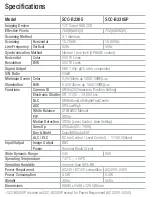
DSP-100 User Manual
Page 15 of 25
DSP100_MAN_A
inductance should be twice the lead-in inductance. To approximate the loop inductance, use the following
formula:
L = (P / 4) x (N + N
2
)
Where:
L = Loop Inductance in microhenries (µH)
P = Perimeter of loop in feet
N = Number of turns in the loop
For example, a typical 6’x6’ loop with 3 turns would have an inductance of
L = ( (6 + 6 + 6 + 6) / 4) x (3 + 3
2
)
L = (24 / 4) x (3 + 9)
L = 6 x 12
L = 72 µH
Loop Inductance is approximately 72 µH. The approximate inductance of a 250’ lead
-in cable was calculated using
a value of .22 µH per foot. That should equal about 55 µH for the lead-in. A good installation should have a loop
inductance to lead-
in inductance ratio of at least 2 to 1. So, with a 250’ lead
-in and inductance of 55 µH, the loop
inductance should be at least 110 µH. So, in our example of a 6’ x 6’ loop with
three turns yielding an inductance
of 72 µH is not a good installation.
A four turn 6’ x 6’ loop would have an inductance of approximately 120 µH and
would there meet the ratio guideline. If you are unsure about your particular installation, call tech support for
guidance.
Installation Practices:
Permanent loops should be installed into the road surface by cutting slots into the road
surface using a saw with an appropriate cutting disk for the road surface.
The slot cut should be wide enough that the wire being used will easily fit into the slot. This is needed so that the
loop sealant used can fully encapsulate the wire. When the wire fits tightly in the slot, the sealant may not be
able to get below the wire, leaving air pockets in the saw slot. If water finds its way into these air pockets, over
time, freeze/thaw cycles can slowly jack the loop out of the saw slot causing loop failure.
The saw slot should be deep enough that the loop wire will have a minimum of ½” of sealant over the top wire in
the slot. More is better. Going too deep with the saw cut is also a concern. Deep cuts in a road surface may
impact the structural strength of the roadway, especially if any reinforcement material is cut. Using a smaller
gauge of wire will allow for shallower saw cuts.











































